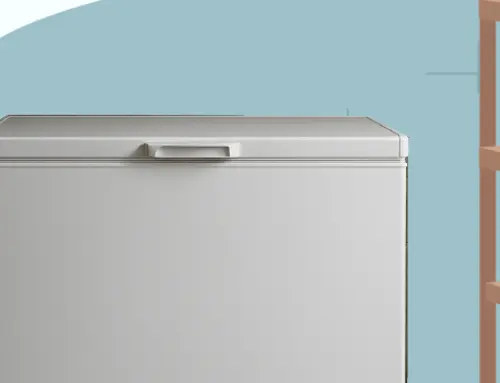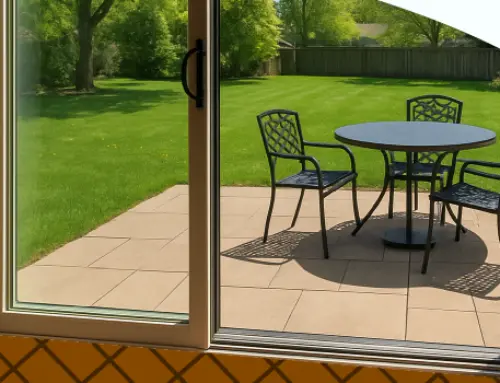Why Are My Air Conditioner Evaporator Coils Freezing?
by Tyler Castle
21.8 min read
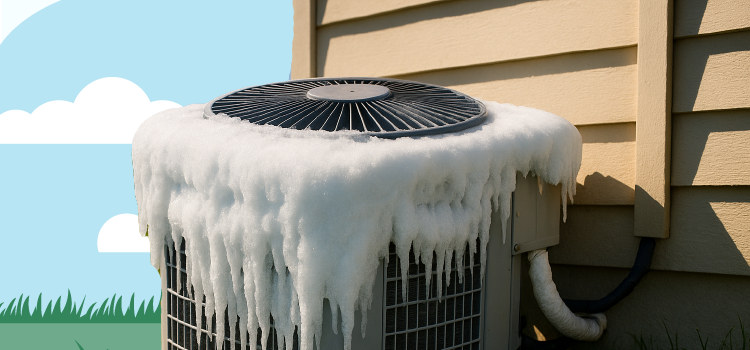
If your air conditioner isn't blowing cold air, or worse, you notice ice buildup inside your unit, you might be dealing with frozen evaporator coils. While it may sound like a minor inconvenience, this issue can lead to poor performance, higher energy bills, and long-term damage to your AC system if not addressed quickly.
Frozen coils are one of the most common (and most misunderstood) air conditioning problems homeowners face, especially during high-humidity months in the Midwest. As energy experts with decades of experience guiding homeowners through seasonal energy needs, we know that frozen coils can quickly disrupt comfort and efficiency.
Keep reading to learn what causes frozen coils, how to spot the warning signs, and the exact steps you can take to fix the problem before it leads to costly repairs.
Key Points of This Article:
- Restricted air flow is one of the most important signs that your air conditioner’s evaporator coils are frozen.
- Look for ice buildup on indoor units or copper lines, weak airflow from vents, your AC running but not cooling effectively, water leaking around the indoor unit, and short cycling. These are all signs your air conditioner coil might be frozen.
- Simple maintenance, such as regular filter changes, keeping vents unblocked, and annual coil cleaning, can prevent the $600-$2,700 cost of evaporator coil replacement while keeping energy bills manageable.
What Is a Coil in an Air Conditioner and What Does it Do?
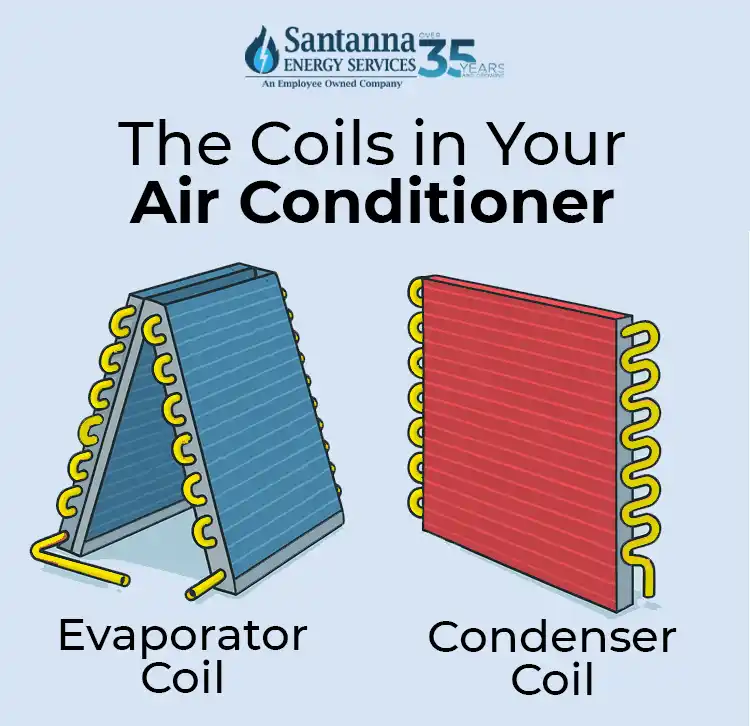
Your air conditioner has two important coils that help it cool your home: the evaporator coil and the condenser coil. The evaporator coil, located inside your home, is responsible for absorbing heat and moisture from the indoor air. The condenser coil, on the other hand, is located in the outdoor unit and releases that heat into the outside air.
Think of your coils like this: Your air conditioner works like a sponge and a wringer.
Inside your home, the evaporator coil acts like a sponge, soaking up heat from your indoor air. That heat doesn’t just disappear; it hitches a ride outside through refrigerant lines.
Outside, the condenser coil acts as the wringer, squeezing the heat from the indoor air and releasing it outside. The cooled air travels back inside. The result? The air in your home stays cool and comfortable, while the unwanted heat is sent packing outdoors.
As you can see, the evaporator coil is an important part of your air conditioning system. If the evaporator coil isn’t working properly, your AC won’t be able to cool the air and your home, making your indoor air feel more humid than usual. And who wants that when it’s 90 degrees outside?
That’s why it’s so important to understand what a coil in your conditioner is and how it works. When trouble strikes, you’ll know what to look for and what it means when your system goes down.
Where is My Air Conditioner Coil Located?
Whether you’re experiencing issues with your condenser or evaporator coil, knowing the location of your coil is essential.
Evaporator Coil (Inside Your Home)
The evaporator coil is located inside your home, typically in one of these places:
- On top of your furnace or air handler (if you have a central HVAC system)
- Inside a metal cabinet connected to your ductwork
- Above or beside the blower fan in your indoor unit
If you have a vertical furnace setup (common in basements or closets), the coil sits on top. If it’s a horizontal system (in an attic or crawl space), the coil may be placed beside or underneath the blower.
This coil is usually housed inside a sealed compartment, so you won’t always see it unless the access panel is opened, usually by an HVAC technician during maintenance.
Condenser Coil (Outside Your Home)
The condenser coil, on the other hand, is located in your outdoor unit, situated outside your home. It’s often referred to as the AC “box” in your yard by air conditioning professionals.
It’s usually a large, square or rectangular metal unit with a fan on top or inside your unit itself. In most cases, you will need to remove the outer covering of your unit to access it.
Why Is My Air Conditioner Evaporator Coil Freezing?
If you’ve noticed ice on your air conditioner or warm air blowing from the vents when your AC unit is cranked down, there’s a good chance your evaporator coil is frozen. This is one of the most common problems you can encounter with your air conditioning unit, especially in homes across the Midwest during humid months.
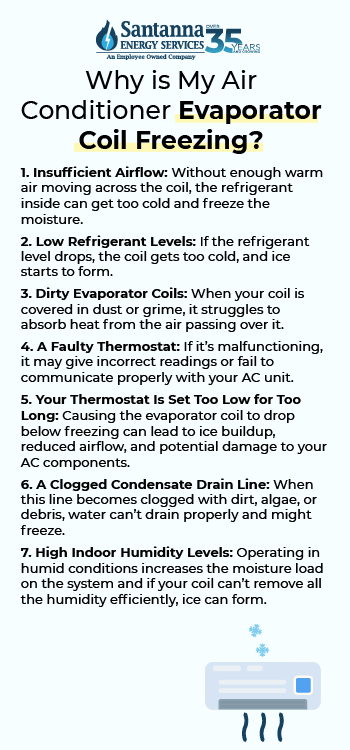
Let’s break down the most common causes of why your evaporator coil is freezing and how they all connect to airflow, refrigerant, and system performance:
1. Insufficient Airflow
Airflow is crucial to keeping the coil at the right temperature. Without enough warm air moving across the coil, the refrigerant inside can get too cold and freeze the moisture. This means that insufficient airflow can most definitely cause your evaporator coils to freeze.
If this is an issue for you, try inspecting your air filters. We’ve found that dirty air filters are the most common reason for restricted airflow. When filters are clogged with dust or pet hair, they prevent warm air from reaching the coil, which could cause your evaporator coils to freeze.
Closed or blocked registers (vents) also limit circulation, especially in multi-room homes, and a faulty blower motor can weaken or completely stop airflow, leading to a frozen coil.
Changing your air filter every 1–3 months is one of the easiest ways to prevent insufficient airflow and frozen coils.
2. Low Refrigerant Levels
Low refrigerant levels can be a contributing factor to a frozen evaporator coil. Your evaporator coil depends on refrigerant to absorb heat. If the refrigerant level drops, the coil gets too cold, and ice starts to form.
Over time, refrigerant depletion can also occur in older systems that haven’t been serviced regularly. If you have an old air conditioning unit, it’s essential to monitor your refrigerant levels to prevent this issue from leading to costly consequences. Without question, refrigerant issues must be handled by a licensed HVAC technician.
3. Dirty Evaporator Coils
When your coil is covered in dust or grime, it struggles to absorb heat from the air passing over it.
This disrupts the heat exchange process, causing the coil’s surface temperature to drop below freezing in some areas. As warm air can’t properly circulate and transfer heat, moisture in the air condenses on the cold coil and freezes, forming ice.
Regular cleaning of your evaporator coil not only prevents freezing but also improves energy efficiency and extends the life of your system!
4. A Faulty Thermostat
Another cause of a frozen evaporator coil comes from a faulty thermostat. A bad thermostat can throw off your system’s whole cooling process. Your thermostat acts as the “brain” of your HVAC system, signaling when to turn the cooling on or off based on the indoor temperature. If it’s malfunctioning, it may give incorrect readings or fail to communicate properly with your AC unit.
This can cause your system to run longer than necessary and might cause the temperature of your evaporator coil to plunge below freezing, leading to frozen coils.
5. Your Thermostat Is Set Too Low for Too Long
Operating your AC at extremely low temperatures can lead to freezing, especially when paired with poor airflow. As a rule of thumb, according to the New York Department of Health, never set your thermostat below 55°F. Not only is this hazardous to your health, but it can also disrupt your cooling system by causing the evaporator coil to drop below freezing. This can lead to ice buildup, reduced airflow, and potential damage to your AC components.
6. A Clogged Condensate Drain Line
The condensate drain line is designed to carry away the moisture that collects on your evaporator coil during the cooling process.
When this line becomes clogged with dirt, algae, or debris, water can’t drain properly and starts to back up in the pan or around the coil. This standing water can then freeze on the coil, especially when the system is running continuously. If you don’t act fast to clean your coil, this could lead to water damage, mold growth, and your system working less efficiently.
7. High Indoor Humidity Levels
While it might not seem like it, high indoor humidity can cause your air conditioning evaporator coils to freeze. Operating in humid conditions increases the moisture load on the system, and if your coil can’t remove all the humidity efficiently, ice can form.
High humidity also forces your system to work harder, increasing energy use and accelerating wear and tear. Proper humidity levels in your home should fall between 30% and 50%.
How to Tell If Your Evaporator Coils Are Frozen
Frozen evaporator coils don’t always scream for attention, but the signs are there if you know what to look for. Spotting the issue early can help you avoid a full system shutdown, water damage, or expensive repairs.
Here are the most common signs your air conditioner evaporator coil may be frozen:
1. Ice on the Indoor Unit or Copper Lines
Look for ice buildup on the evaporator coil itself, or on the copper refrigerant lines near the indoor unit or the air handler. Ice may appear frosty at first, then become a solid block over time. Even a thin layer is a red flag.
2. Weak or No Airflow from Vents
When the coil is frozen, air can’t pass through it properly, which means your system will blow very little air, or sometimes none at all. You might also feel warm or room-temperature air coming from your vents. Check your vents to see for yourself if there’s weak air flow.
3. Your AC Is Running but Not Cooling Your House
If your thermostat is set correctly but your home still feels warm or humid, the system may be running constantly with little to no cooling. That’s often because the frozen coil is blocking the heat exchange process.
4. There’s Water Leaking Around the Indoor Unit
As the ice on your coil begins to melt, it can overwhelm the condensate drain pan. This often leads to water pooling on the floor, especially near the furnace or air handler.
If you notice water damage around your HVAC unit, shut it off and call a professional. Melting coils can cause leaks in ceilings or walls in some setups.
5. Your AC Turns On and Off Rapidly (Short Cycling)
A frozen coil can confuse your system, causing it to short-cycle, where it turns on and off too quickly before reaching the right temperature. This puts extra strain on your compressor and increases wear on your system, and could mean your evaporator coil is frozen.
How to Troubleshoot Frozen Evaporator Coils in an Air Conditioner
When your AC coils freeze, it’s not just a comfort issue; it can lead to water damage, high energy bills, or serious system damage if ignored. But before you try anything else, the most important thing is to stay safe.
Here’s what to do if you think your evaporator coil is frozen:
Step 1: Switch Off the System at the Main Breaker
Always begin by switching off the power to your entire HVAC system at the main breaker panel, not just the thermostat. This protects you from electric shock, especially if water has pooled near the unit or you plan to open any access panels. AC systems carry high voltage, and turning off power ensures you can inspect components safely.
Step 2: Switch the Thermostat to “Fan Only” Mode
If conditions are dry and you’re not operating your unit, you can run the fan to help melt surface ice. But if there’s any sign of water pooling or exposed wiring, skip this step and make sure you switch off the power to your entire HVAC system at the main breaker panel.
Step 3: Identify Your Issue and Start by Checking and Replacing the Air Filter
A frozen evaporator coil could come from anywhere, so it’s important first to identify the main issue, other than your coil being frozen.
A clogged or dirty air filter is one of the most common reasons evaporator coils freeze. When airflow is restricted, the coil can’t absorb heat properly, and moisture freezes around it.
Remove the filter and check for dust or discoloration. If it’s dirty, replace it with a clean one to restore airflow and reduce strain on your system. If your air filter is frozen onto your system, don’t panic! Once it thaws, you can replace your dirty filter then.
Step 4: Inspect Your Vents and Registers
Walk through your home and make sure all supply and return vents are open and unblocked. Furniture, curtains, or rugs should never cover vents, as this can restrict airflow and throw off system pressure. If certain rooms feel stuffy or weak in airflow, it could point to an issue inside the ductwork.
Step 5: Observe the Blower Motor (If Accessible)
Once the system is powered down, open the air handler panel (if safely accessible) and observe the blower fan. Does it spin freely? Are there signs of dust buildup or signs that it’s struggling to turn?
A failing blower fan can significantly reduce airflow and contribute to coil freezing. If it’s not spinning properly or making odd sounds, professional repair may be needed.
Step 6: Monitor Refrigerant Levels
Low refrigerant is another common cause of freezing. If your system is low on refrigerant or leaking, the evaporator coil can drop below freezing and cause moisture to ice over. Only licensed HVAC technicians can check and refill refrigerant, so if you’ve ruled out airflow issues and still see ice forming, it’s time to schedule a service call.
Step 7: Inspect for Blocked Drain Line
As your AC removes humidity, the water it collects drains through a small pipe or tube. If this condensate drain line is clogged, water can back up and refreeze on the coil. Look for standing water or wet spots around the indoor unit. If you suspect a clog, you can flush the line with vinegar or use a wet/dry vacuum; otherwise, a technician can safely clear it during maintenance.
Step 8: Safely Thaw the Frozen Coil
Allow the ice on the evaporator coil to melt naturally. This can take several hours, depending on the extent of the freeze, which means your system could be down for several hours. If it’s a hot day, ensure you have an alternative cooling plan to stay comfortable while this is taking place.
You can speed up the process slightly by running a fan over the coil (without turning the AC back on) to circulate air and help melt the ice.
It’s important to never attempt to chip or pry the ice off, as this can damage the delicate fins of the coil. Once the ice has fully melted, check for standing water in the drain pan and ensure the drain line is clear before restarting the system.
Step 9: Consider Professional Assistance
If your coil continues to freeze even after these steps, or if you’re unsure about what you’re seeing, it’s best to contact a certified HVAC technician. They can test refrigerant pressure, inspect internal components, and run a full diagnostic to prevent long-term damage.
How to Clean Your Air Conditioner Evaporator Coils Safely
Over time, your air conditioner’s evaporator coil collects dust, dirt, pet hair, and even mold. When that buildup gets bad enough, it creates a barrier that blocks heat transfer. That means your system has to work harder, run longer and in many cases, the coil can freeze due to restricted airflow or uneven temperatures.
According to the U.S. Department of Energy, a dirty evaporator coil can reduce your AC’s efficiency, increase your energy bill, and shorten the life of your system. Here’s how to clean your air conditioner evaporator coils safely:
What You’ll Need
- Screwdriver (if the access panel must be removed)
- Flashlight
- Soft brush (like a paintbrush or toothbrush)
- Fin comb (optional, for straightening bent fins)
- Mild coil cleaner (see recommended options below)
- Gloves and safety goggles
- Vacuum with a brush attachment (optional)
Before You Begin: Safety First
Air conditioners, if not handled correctly at the beginning of the cleaning process, can spell disaster and danger.
Before anything else, turn off all power to the unit at the main switch or circuit breaker. This is essential. You’ll be working near wiring and delicate components, and if treated lightly, it can lead to electrical shock and injury. It’s important to never clean coils while the system is running.
If your evaporator coil is frozen, let it thaw completely before cleaning it. Trying to clean a frozen coil can damage the fins or motor.
How to Clean Your Air Conditioning Evaporator Coil
Now that we’ve covered safety, here’s your step-by-step guide on how to clean your evaporator coil:
Step 1: Open the Access Panel: Use a screwdriver to remove the metal cover where your evaporator coil is located. It’s typically above or beside the furnace inside a metal cabinet.
Step 2: Gently Remove Loose Debris: Use a soft brush or a vacuum with a brush attachment to clear away surface dust and buildup. Be careful, evaporator fins are delicate and can bend easily.
Step 3: Apply Coil Cleaner: Use a no-rinse evaporator coil cleaner (available at most hardware stores). Spray it evenly across the coil. The foam will expand and loosen grime, then slowly drip into the drain pan.
For stuck-on grime, use a microfiber cloth to wipe your coil clean and never use bleach or harsh chemicals. They can corrode the coil and damage your system. Use a product labeled specifically for evaporator coils.
Step 4: Check the Drain Line: While cleaning the coil, take a look at the condensate drain line. A clogged drain can cause water to back up and freeze on the coil. Pour a small amount of water or vinegar through it to check the flow.
Step 5: Close the Panel and Restore Power: After everything dries (usually within 15–30 minutes), replace the panel, turn the power back on, and set your thermostat to cool.
Our Recommendations for Coil Cleaner for Your Air Conditioner
These coil cleaners are designed specifically for evaporator and condenser coils. They’re safe for aluminum and copper, and most are no-rinse formulas, which means the foam breaks down and drains away on its own.
We have your list for the best ones. Always follow the instructions on the label for the best results.
- Simple Green® Foaming Coil Cleaner: A non-toxic, biodegradable formula that clings to vertical surfaces and removes grime without harsh fumes.
- AC-Safe Air Conditioning Coil Foaming Cleaner: Easy-to-use, aerosol-style cleaner that dissolves dust and grease quickly; no rinsing needed.
- PURAFILTER 2000 Coil Cleaner: Ideal for homeowners looking for a gentle, non-acid formula; works well on light dirt buildup and is safe for indoor use.
- DiversiTech Pro-Blue Foaming Concentrate Coil Cleaner: A professional-strength alkaline foam cleaner designed for heavy-duty applications; best used with dilution and outdoor ventilation.
- QwikProducts QT2770 QwikClean No-Rinse Foaming Coil Cleaner: A foaming, no-rinse cleaner that’s effective on both evaporator and condenser coils; widely used by HVAC technicians.
What’s the Cost of an Air Conditioner Coil Replacement?
After everything we’ve covered about frozen evaporator coils, including proper maintenance and recognizing the warning signs, it all comes down to one goal: helping you prevent costly repairs. Ignoring the problem now is the surest way to face bigger issues down the line.
If you do find yourself in the market for an air conditioner coil replacement, here’s what to know:
Replacing an evaporator coil in your air conditioner usually costs between $600 and $2,700. This price typically covers both the labor and the refrigerant needed for the job.
If your system is still under warranty, your total cost may be lower, since the coil itself may be covered, and you’d mainly be paying for the technician’s time and any extra parts needed.
Here’s a breakdown of what you can expect to pay based on the size of your AC system:
Average Cost of an Evaporator Coil Replacement by AC Size
| AC Unit Size | Low Cost | Average Cost | High Cost |
| 2 ton | $550 | $1,250 | $2,000 |
| 2.5 ton | $650 | $1,400 | $2,100 |
| 3 ton | $700 | $1,550 | $2,350 |
| 3.5 ton | $750 | $1,650 | $2,500 |
| 4 ton | $800 | $1,700 | $2,600 |
| 5 ton | $900 | $1,800 | $2,700 |
To put this in perspective, here’s how this expense compares to other common home maintenance projects:
- Basic home winterization (like weatherstripping, sealing leaks, or attic insulation) typically costs $200 to $1,000. More extensive upgrades can run $1,000 to $5,000 or more.
- Furnace inspections cost about $100 on average, with most homeowners paying between $80 and $200 depending on the furnace type and size.
- Refrigerator coil cleaning is a small maintenance task that can be done as a DIY project, or costs $75 to $200 if done professionally.
- Smart thermostat installation typically ranges from $150 to $500, depending on features and whether it’s professionally installed.
Compared to other common home projects, a coil replacement comes with a significant cost. That’s why it’s important to address issues promptly, perform regular maintenance, and pay attention to warning signs. Taking care of small problems early can help you avoid major repairs and protect your investment in the long run.
Why Frozen Coils Are Bad for Your AC and Your Energy Bills
When coils freeze, airflow gets blocked, making it harder for your system to cool your home. This forces your AC to run longer, use more electricity, and work under strain, all of which can quickly spike your energy bills.
If left untreated, frozen coils can lead to short cycling, water leaks from melting ice, and worst of all, damage to critical parts like the compressor or blower motor, which are costly to replace.
Even after the ice melts, your system doesn’t just bounce back—it’s been overworked. Catching and fixing the problem early helps you avoid major repairs, reduce energy waste, and keep your home consistently comfortable.
How to Prevent Frozen Coils in the Future
The good news is that most frozen coil problems can be avoided with simple, routine maintenance and smart system habits. Preventing your air conditioner’s evaporator coil from freezing not only helps your system run more efficiently, but it also protects it from costly repairs and extends its lifespan.
Here’s what you need to know to stay ahead of the problem:
1. Replace Your Air Filter Regularly
A clogged or dirty air filter is the number one cause of restricted airflow, which is the leading reason coils freeze. If your filter looks gray or dusty, it’s time to swap it out. Replace your filter every 1–3 months or more often if you have pets or allergies, to keep air moving freely and help your system breathe better.
2. Keep Vents and Registers Open and Unblocked
Make sure air supply and return vents are fully open and free from furniture, curtains, or rugs. Blocking vents reduces airflow across the coil, increasing the chance of freezing.
3. Clean the Evaporator Coil and Drain Line Annually
Dust and debris can build up on the evaporator coil over time, making it harder to absorb heat. A dirty coil traps moisture and raises the risk of ice buildup. Likewise, a clogged drain line can prevent water from draining and allow it to refreeze.
4. Don’t Set the Thermostat Too Low
Setting your thermostat too low for extended periods, especially on humid days, can cause your air conditioner to overcool. When that happens, the evaporator coil may not get enough warm air to keep it from freezing.
Instead of cranking the AC as low as it can go, aim for a comfortable setting that allows your system to run efficiently without stressing the coil. This helps maintain steady airflow, reduce humidity naturally, and prevent ice from forming inside the unit.
5. Address Humidity Issues
If your home feels sticky or humid, consider using a dehumidifier or upgrading your HVAC system with humidity control features. Excess moisture in the air can speed up ice formation on the coil.
6. Schedule Annual HVAC Maintenance
Professional technicians can catch early signs of trouble before they cause a freeze-up. A seasonal check-up also includes cleaning, testing, and adjusting components for peak performance.
FAQs
How long does it take for frozen coils to thaw?
It typically takes 1 to 4 hours for evaporator coils to thaw completely after turning off the AC. Running the system’s fan only (without cooling) can speed up the process by circulating warm air. If the coil is heavily frozen, it may take longer.
Can I pour hot water on a frozen coil?
No. Pouring hot water directly on a frozen coil can crack the metal or damage internal components due to a sudden temperature change. It’s safer to turn the system off and let the ice melt gradually. If faster thawing is needed, use the fan-only setting.
Will running the fan help thaw the coils?
Yes. Switching the thermostat to “fan only” mode helps circulate warm indoor air over the coils, which accelerates the thawing process without activating the cooling cycle.
Is it safe to run the AC with frozen coils?
No. Running your AC while the coils are frozen can severely damage your compressor, overwork the system, and lead to higher energy bills. Always turn the cooling function off and address the cause before restarting the unit.
Frozen evaporator coils are more than just a cooling issue; they’re a sign your system is under strain. With simple maintenance like replacing air filters, checking airflow, and monitoring your system’s performance, you can prevent freeze-ups and keep your AC running efficiently.
Taking care of your home comfort isn’t just about maintenance; it’s also about making smart energy choices. With Santanna’s energy solutions, you can lock in pricing, avoid seasonal rate spikes, and choose an option that fits your household’s needs. Explore our energy plans today and protect both your home and your budget all year long.
Tyler is an experienced energy professional, having worked for Santanna Energy Services, for the past four years. He is passionate about renewable energy and believes that diversifying the energy grid is the key to a sustainable future. Tyler is dedicated to supplying consumers with the best possible energy solutions and works diligently to make sure that Santanna can deliver the highest quality service.




